Abstract
This study presents a digital forensic facial approximation of Wenceslas, Duke of Bohemia (ca. 907–935), based on photographs of the skull attributed to the saint, preserved in St. Vitus Cathedral, Prague. The skull was replicated through structural deformation using public domain images, adjusted to historical measurements, and enriched with anthropometric data. The facial approximation combined traditional techniques with statistical projections from tomography of living individuals, resulting in two versions: an objective one and another with artistic and more speculative elements based on historical descriptions. Comparisons with Petr Parler’s 14th-century statue and a previous reconstruction revealed structural consistency, suggesting the skull may have inspired the sculpture. This work contributes to humanizing historical figures and reinforces Wenceslas’s legacy as a Czech icon.
1. Introduction
1.1. Who Is Wenceslas?
Wenceslas of Bohemia or Saint Wenceslas, born around 907, was a duke of Bohemia—within the territory of present-day Czechia—and a pivotal figure of the Přemyslid dynasty, representing its third generation. The son of Duke Vratislav and Drahomíra, a member of the princely Lyutic family of Stodorian Brena, he was raised by his grandmother, (Saint) Ludmila of Bohemia under a profound Christian influence. Following his father’s death in 921, Wenceslas, being too young to govern, remained under his mother’s regency until he assumed power around 925 [1].
Wenceslas furthered the efforts of his uncle Spytihněv in supporting the Bavarian clergy to introduce Christianity into Bohemia. In 929, he confronted the East Frankish king Henry I and the Bavarian duke Arnulf outside Prague, ultimately submitting to Henry I and reestablishing Bohemia’s tributary dependence. That same year, he received the relics of Saint Vitus from Henry I, a gift to which the Saxons attributed significant strategic importance. Wenceslas enshrined these relics in a circular church, the St. Vitus Rotunda, at Prague Castle, where the Prague bishopric would be established half a century later [2].
On 28 September 935, Wenceslas was assassinated by order of his brother Boleslav, who then seized power [3]. Several years later, likely after 938, his remains were moved to the St. Vitus Rotunda, though sources do not specify the reason for this delay. After the transfer, veneration of Wenceslas began to flourish [2,4]. His cult grew over time, as seen in his name on 11th-century Saint Wenceslas denars [5]. In 1333, King Charles IV, ruler of the Bohemian lands, richly decorated Wenceslas’s tomb, and in 1346 commissioned a royal crown to rest atop his skull, a relic used only for coronations and returned the same day [4]. Charles IV also commissioned a two-meter statue by Petr Parler, possibly modeled on the saint’s skull to reflect his true facial features [2,6].
In popular culture, Saint Wenceslas is widely recognized in the English-speaking world through the Christmas carol “Good King Wenceslas,” composed by John Mason Neale and published in his collection Carols for Christmas-tide (1853). Inspired by the life and legacy of Saint Wenceslas, the work reflects an idealized portrayal of his figure as a benevolent and pious ruler, cementing his memory within a cultural and religious context that transcends the boundaries of medieval Bohemia and resonates to this day.
1.2. Archaeological and Anthropological Studies
Wenceslas’s tomb underwent improvements and reconditioning of the remains over the centuries, though it also faced periods of apparent indifference or neglect, culminating in 1905 with a significant donation for a new altar. This necessitated opening the site housing the remains, a task completed in 1911 [4].
The analysis of the remains associated with St. Wenceslas (Figure 1) was conducted between April and May 1911 by anthropologist Jindřich Matiegka (1862–1941). As reported by the expert:
The purpose of the investigation was not to prove the identity of the individual; there was no reason to doubt that the remains of St. Wenceslas had been preserved for us; after all, these are not the remains of an ordinary person, but those of a duke, and a Czech domestic prince; there is no doubt that his tomb was specially marked and known as such from the beginning. The tombs and remains of other Czech princes from that era have also been preserved [7].
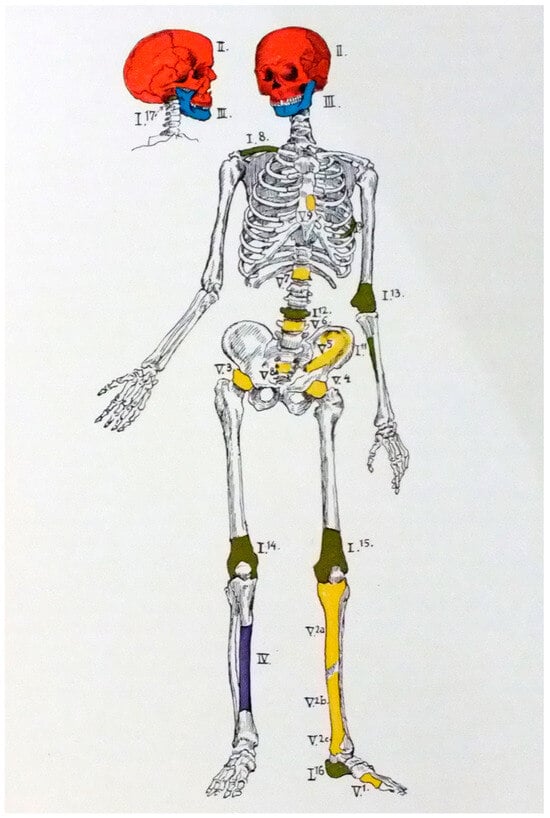
Figure 1.
Bone remains found, attributed to St. Wenceslas. Jindřich Matiegka, public domain (https://cs.wikisource.org/wiki/Soubor:Summary_of_St_Wenceslas_remains.jpg, accessed on 5 June 2025). The engraving represents groups of bone pieces found separately, pigmented (in groups or single pieces) in black, red, blue, and yellow, all, according to Matiegka (1934) [7] belonging to a single skeleton, in this case, Wenceslas of Bohemia. The white regions are those missing.
Matiegka’s detailed work enabled the cataloging and measurement of a set of nine bone remains, with the skull attributed to St. Wenceslas standing out, alongside a series of measurements. According to the expert, the evidence pointed to an individual of Nordic ancestry, characterized by:
This type includes blond hair and blue eyes. Historical sources, even the oldest depictions, insofar as they can be applied here, do not contradict this concept of St. Wenceslas’s physical nature; on the contrary, they align with it [7].
Based on prior studies, anthropologist Emanuel Vlček (1925–2006) deduced various details about Wenceslas. He argued that the identity of the remains was corroborated by multiple documentary authentications, traditions linked to the burial sites, and the remains’ millennium-long presence at the site of the rotunda he had built. The evidence clearly indicated a male individual, as the skull, according to the analysis, presented typical male characteristics, including, well-developed supraorbital arches on the inner halves of both orbital cavities, a significantly developed glabella, a sloping forehead, a well-developed zygomatic arch, and a more closed mandibular angle. Regarding age at death, Vlček noted that while cranial suture closure might suggest an individual over 60, the condition of the dental alveoli pointed to an age range about two decades younger, estimated at 42.2 ± 4.8 years (37.4–47). Another analysis proposed an age between 35 and 40, aligning with the currently accepted 32 years, although the author suggests Wenceslas may have been born before 907. From the nearly intact left tibia, his height was estimated between 160–165 cm. A forensic facial reconstruction of the profile was performed, yielding different versions: one with the skull overlaid with skin, another without hair or beard, and two complete versions with hair and beard: one depicting him at 30 with a crown, and another at 40 with a denser beard. Vlček also highlighted Petr Parler’s statue, suggesting it was modeled on Wenceslas’s skull, constituting the first historical reconstruction based on its measurements, a hypothesis supported by Vlček’s projection. However, he notes inconsistencies, explained by details like the nose area, completed in 1866 by another sculptor centuries after the original work [2].
1.3. New Digital Facial Approximation
The authors of this study have contributed over the years to the reconstruction of the history of key personages of the Czech Republic through forensic facial reconstructions, many published in peer-reviewed academic journals. In total, 16 reconstructions have been completed, including the Zlatý kůň fossil, dated to approximately 43,000 years BP [8], the Hussite general Jan Žižka [9], and several figures directly tied to the Přemyslid family, such as Vratislav I of Bohemia [10], Spytihněv I of Bohemia [10], and Ludmila of Bohemia [11]. Notably, the case of Adalbert of Prague [12] is included in the official name of St. Vitus Cathedral—St. Vitus, Wenceslas, and Adalbert—reflecting the coherence of this research line and justifying the choice of St. Wenceslas as the next face to be reconstructed. Beyond his Přemyslid lineage and presence in the name of a building symbolizing the nation [13], he is also the patron saint of the Czech Republic [14].
This study aimed in a pioneering manner to three-dimensionally reconstruct the face of Wenceslas of Bohemia through a rigorously peer-reviewed process, enabling the provision of images under a free license (Creative Commons) and facilitating derivative works, such as 3D bust prints and statue compositions. As open-access material, the data will be shared transparently, encompassing not only free images but also a replicable methodology developed using open-source software and accessible sources.
2. Materials and Methods
This study explored the use of forensic facial approximation (FFA), a technique grounded in anatomical projections and statistical analyses derived from a dry skull to estimate an individual’s appearance during life. In forensic contexts, this method is frequently employed in cases where the victim’s identity is unknown, producing a facial representation that enables preliminary identification, later substantiated by techniques such as dental analysis or DNA testing. Although the authors bring considerable experience in forensic applications [15], the present work focused on reconstructing a figure of historical and religious significance. The primary aim was to assign a face to a relic, fostering a connection with the public through a more accessible and humanized depiction.
All work described herein was conducted using open-source, free, multi-platform software. For 3D modeling, Blender 3D 2.91(https://www.blender.org, accessed on 5 June 2025) was used with the OrtogOnBlender 2.91 add-on (https://www.ciceromoraes.com.br/doc/pt_br/OrtogOnBlender/, accessed on 5 June 2025), which enhances the native program with tools for importing computed tomography scans, photogrammetry, forensic facial reconstruction, and AI-driven image enhancement. Graphics were created using GIMP 2.10 (https://www.gimp.org, accessed on 5 June 2025) and Inkscape 1.2 (https://inkscape.org, accessed on 5 June 2025). These tools were run on Ubuntu Linux 24.04 (https://ubuntu.com, accessed on 5 June 2025), though being multi-platform, they are also compatible with Windows and macOS.
The process requires a fully digitized 3D skull. Here, photographs of the skull attributed to St. Wenceslas, available in the public domain on Wikimedia Commons (https://commons.wikimedia.org/, accessed on 5 June 2025), were used to create a corresponding digital anatomical piece via structural deformation [16]. A virtual donor skull, derived from a 3D-reconstructed tomography scan, was imported into the scene and aligned with the Frankfurt horizontal plane. Multiple digital cameras were then added, using reference photographs as backgrounds, aligning both cameras and images to the donor skull. Structural adjustments transformed the donor skull into one compatible with St. Wenceslas’s (Figure 2). The initial adjustment was based solely on proportions, with the skull later scaled to real dimensions using the measurements documented by Matiegka (1934) [7]. For the calibration of the skull size, three primary external measurements were used as a basis: the maximum length (185 mm), the maximum width (131 mm), and the basion-bregma height (135 mm), which define the rectangular volume encompassing the skull. In addition to this, 52 other measurements, including facial, mandibular, and cranial indices, are available for detailed consultation in the document referenced in Matiegka (1934) [7]. For the skull reconstruction, four freely licensed images available on the internet were used (Figure 2A–D), selected in accordance with the project’s premise of employing resources accessible to anyone interested in replicating the methodology. For this reason, media from the Wikimedia Commons portal were chosen. To validate the structural coherence of the model, proprietary images from the Prague Castle collection were utilized (Figure 2E), with camera metadata available, enabling the configuration of a virtual camera compatible with the real one. This approach confirmed that the model reconstructed from the four openly available images was compatible with the proprietary photographs from the official collection. After the completion of the forensic facial approximation process, a complementary comparison stage for volumetric evaluation of the skull was carried out using a 3D digitized model from proprietary photos of Prague Castle through the photogrammetry process. This test will be addressed in Results and Discussion.
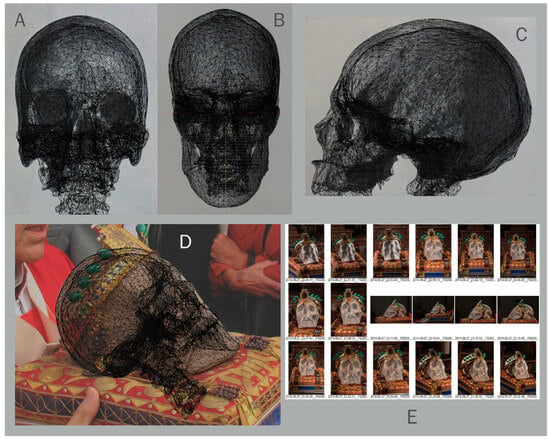
Figure 2.
Adjustment of a virtual donor skull over photographs (3D camera backgrounds) in the public domain. Credit: Jindřich Matiegka. (A) St. Wenceslas’s skull—(https://commons.wikimedia.org/wiki/File:St_Wenceslas_skull.jpg, accessed on 5 June 2025). (B) Complete skull of St. Wenceslas, the Prince of Bohemia, including the lower jaw (https://commons.wikimedia.org/wiki/File:Complete_St_Wenceslas_skull.jpg, accessed on 5 June 2025). (C) St. Wenceslas’s skull (https://commons.wikimedia.org/wiki/File:St_Wenceslas_skull_2.jpg, accessed on 5 June 2025). (D) Lebka sv. Václava, kterou nese kardinál Miloslav Vlk. Credit: Kmenicka (https://commons.wikimedia.org/wiki/File:Lebka_vaclavova_(cropped).JPG, accessed on 5 June 2025). (E) Set of official images of the skull of Saint Wenceslas belonging to the collection of Prague Castle (not available on Wikimedia Commons) used for structural validation of the skull from different points of view.
For the facial approximation, the approach of Moraes et al. (2024) [9] was adopted, combining traditional facial approximation methods with complementary techniques based on measurements from living individuals’ tomography scans, alongside anatomical adjustment of a virtual donor. The final bust resulted from interpolating all data, prioritizing statistical and anatomical coherence.
From anatomical points positioned on the reconstructed skull, projections were made based on measurements from tomography scans of living individuals of varying ancestries [9]. These projections estimated the positions of the eyeball, ear, nose, and lips, as well as cranial structure. Here, some estimates aligned with the reconstructed structure, including the nasolabial point (Figure 3A 1), the lower limit of the upper incisors (Figure 3A 2), and the lower limit of the chin (Figure 3A 3). This consistency allows the tool to project expected structure locations and reconstruct missing skull regions [9]. The tool’s functionality is detailed in two online video tutorials (Lesson 1: https://www.youtube.com/watch?v=U6oYkEmfyW, accessed on 5 June 2025; Lesson 2: https://www.youtube.com/watch?v=Vcz2e5uSFX8, accessed on 5 June 2025). It is important to note that some of the lessons available in this section come from videos originally recorded in Portuguese. Therefore, depending on the viewer’s language, it will be necessary to enable subtitles on the video and set them to the desired language.
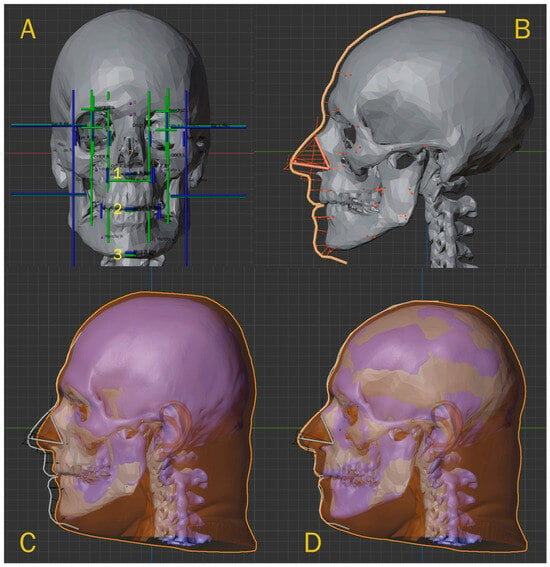
Figure 3.
(A) Reconstructed skull with projections of bone and soft tissue structures. (B) Profile tracing from soft tissue markers and nasal projection. (C) Virtual donor head imported into the scene. (D) Donor head adjusted to the skull attributed to St. Wenceslas.
The digital skull was supplemented with soft tissue thickness markers based on ultrasound measurements from a generic European male population aged 30–39 [17]. This choice was due to the fact that they are based on living individuals, which provides better structural coherence compared to those derived from cadavers. Moreover, although the ancestry includes diverse groups, the individuals are of European origin, consistent with the ancestry of the skull being approximated. As will be seen later, this approach is complemented by other projections; therefore, the final appearance of the face is not limited to these data alone, but results from the interpolation with additional elements.
Nasal projection relied on a complementary technique integrating tomography measurements from living individuals of different ancestries with traditional nasal projection methods, as detailed in Moraes et al. (2024) [9]. Using soft tissue thicknesses and nasal projection parameters, the facial profile was outlined (Figure 3B). A video tutorial on nasal projection is available at https://www.youtube.com/watch?v=F205kLQ--Oo, accessed on 5 June 2025.
To enhance the facial approximation data, a 3D-reconstructed tomography of a virtual donor was imported, incorporating a fused mesh combining general soft tissue (face) and skull (bones) (Figure 3C). This mesh underwent anatomical deformation to align the donor skull with St. Wenceslas’s, reflecting the adjustment in the soft tissue to generate a potentially compatible face. Here, this process yielded a profile aligned with prior projections (Figure 3D). A video tutorial on anatomical deformation is available at https://www.youtube.com/watch?v=xig5_EcIFWA, accessed on 5 June 2025.
Following the approaches outlined in Moraes et al. (2024) [9], an initial bust was developed by interpolating the data from the estimates, achieving consistency in both profile (Figure 4A) and frontal views (Figure 4B). Hair and facial hair were modeled (Figure 4C) with reference to the 1980s lateral facial approximation (an adult man with 30–40 years old) [2]. Facial coloration was guided by Matiegka’s 1911 study describing a Nordic-type individual with blond hair and blue eyes (K tomu typu patří světlý vlas a modré oči) [7], an approach thus marked by artistic and speculative elements. The final rendering underwent detail refinement using artificial intelligence [18], preserving original features to avoid distortion (Figure 4D).
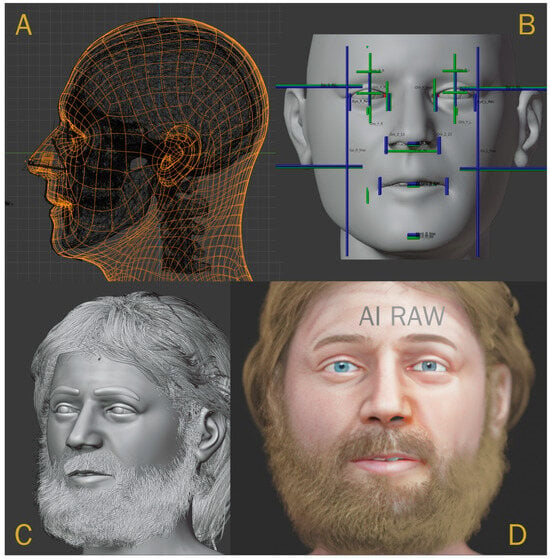
Figure 4.
(A) Adjustment of the basic bust interpolating all performed projections. (B) Frontal view of the basic bust with soft tissue projections. (C) Configuration of hair, beard, mustache, etc. (D) Facial pigmentation, lighting, and detail adjustment with AI tools.
3. Results and Discussion
3.1. Final Images
Two rendering sets were produced: one with a bust featuring more objective elements and another with more artistic and speculative characteristics. The first opted for a normal BMI (body mass index) on the soft tissue table, a bust without hair, with closed eyes, no beard or facial hair, and in grayscale, avoiding highly speculative aspects like eye shape, hair configuration and color, beard, or skin tone, which remained unavailable at the time of this study (Figure 5).
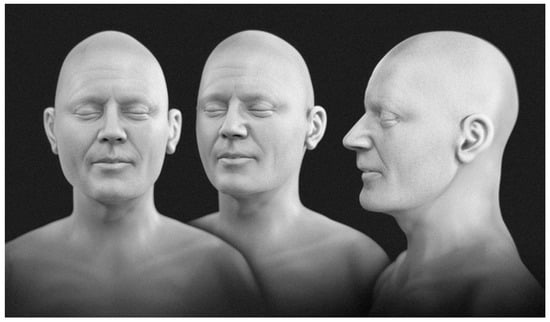
Figure 5.
Objective facial approximation.
Two additional images were created integrating artistic and speculative elements and depicting a low BMI to align with the traditional portrayal of Saint Wenceslas as a slender figure. These reconstructions feature open eyes, hair (accentuating a prominent and visible forehead), a beard, general pigmentation, and attire inspired by Petr Parler’s statue, the 1980s facial reconstruction, and several iconic representations (Vlček, 1997 [2], p. 113) (Figure 6 and Figure 7).
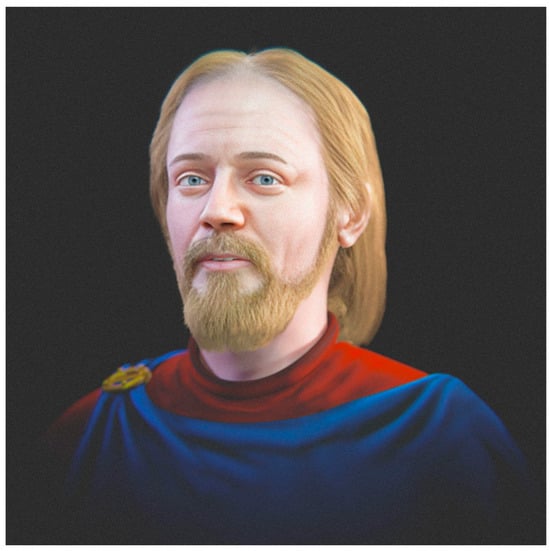
Figure 6.
Artistic facial approximation, 3/4 view.
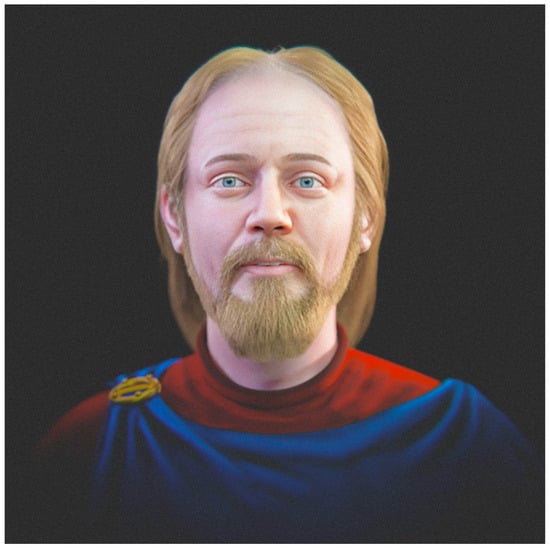
Figure 7.
Artistic facial approximation, frontal view.
3.2. Comparisons
As previously mentioned, an earlier study on facial profile approximation was described in Vlček (1997) [2]. According to the caption detailing the process, it followed the methodology of Lebedinskaya (1998) [19]. Minor differences were noted between the profile images from the 1980s, with the approximation stages consolidated into a single profile (Figure 8, upper center). Although Vlček addresses mandibular retrognathism, also present and more pronounced in Vratislav I [10], this feature appears subtle in the initial stage image of his profile approximation. In subsequent images, the profile assumes a normal appearance without marked upper dental projection, a characteristic more evident in this study (Figure 8, upper left). When comparing the two approximations, mandibular retrognathism is more noticeable, as is the nose in the 1980s work, which appears somewhat less pronounced, likely due to Lebedinskaya’s (1998) [19] technique. In simplified terms, this method reflects the shape from the nasal bone entry to the nasolabial point. While this approach offers significant accuracy regarding the actual nose [20], the method employed here incorporates a complementary process based on tomography measurements from living individuals, considering not only anatomical coherence but also the probable position of the tip derived from intersection data [9]. Generally, except for the lip projection, which was more forward in the 1980s work, the mouth height aligned with this study, as did other structures such as the nose, forehead, and chin, which remained quite similar.
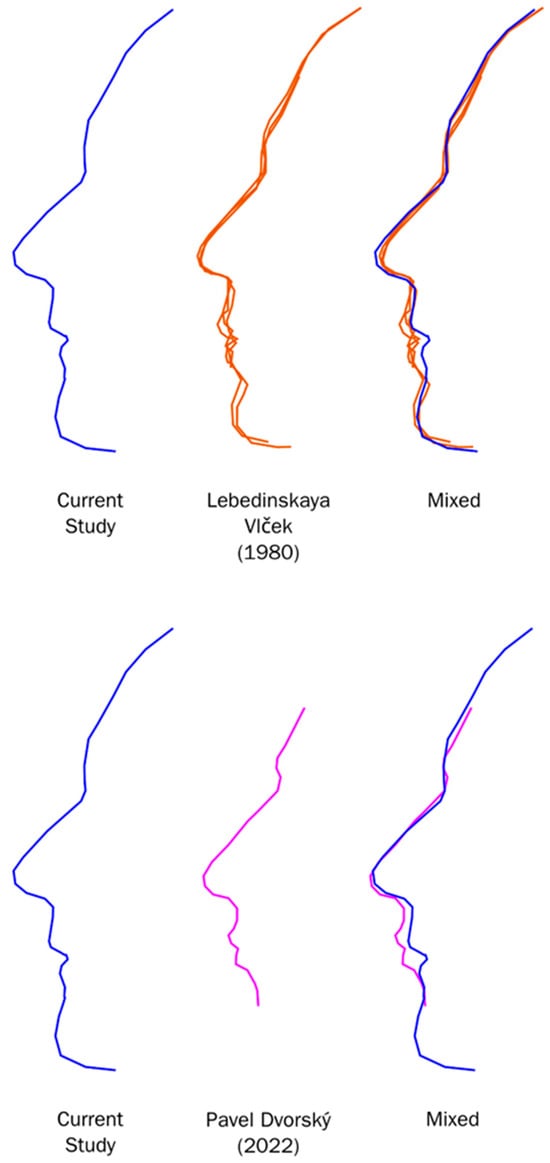
Figure 8.
Comparisons. Upper: between the facial approximation in this project and one conducted in 1980, featured in Vlček (1997) [2]. Lower: between the facial approximation in this project and another conducted by Pavel Dvorský (2022).
The approximation of the present work was also compared with a profile representation created by graphic artist Pavel Dvorský in 2022 (https://www.facebook.com/groups/ceskystredovek/posts/8213831395403806/, accessed on 5 June 2025) based on Wenceslas’s skull. The nose appears consistent with the current work; however, similarly to Vlček’s study, there is no clear evidence of mandibular retrognathism, although the lip height has been preserved (Figure 8, lower part).
One aspect highlighted in Vlček’s (1997) [2] analysis is the hypothesis that St. Wenceslas’s statue, attributed to Petr Parler (Figure 9), had its face modeled on the saint’s skull. For this study, photogrammetry (digitization from photographs) of the sculpture was performed, isolating the facial region and aligning it with the 3D facial approximation. Both representations were kept at a 1:1 scale, and despite some structural differences—due to the statue’s style and execution by different sculptors—evident structural coherence was observed, particularly in the final nose configuration, lip position, facial horizontal limits, and eye placement. These elements support the plausibility of the theory that the skull attributed to St. Wenceslas served as a reference for the modeling, centuries before Gaetano Giulio Zumbo’s (1656–1701) works based on real anatomy [21] and further still from Welcker (1883) [22], who used soft tissue thickness measurements to verify Friedrich Schiller’s death mask compatibility with his skull. Similarly, it predates by centuries the supposed first published facial approximation by His (1895) [23], who applied Welcker’s approach to reconstruct Johann Sebastian Bach’s face from his attributed skull.
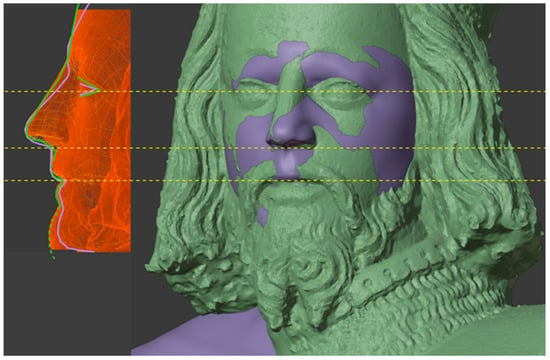
Figure 9.
Comparison between this study’s facial approximation (green in solid form, yellow in wireframe) and the statue attributed to Petr Parler (green in solid form, orange in wireframe). Dotted profile regions correspond to mustache and beard hair, projecting them forward relative to the hairless bust evaluated in the reconstruction.
Within forensic facial approximation, comparisons can be made with reconstructions of Přemyslid dynasty skulls, such as Wenceslas’s face (completed in 2025) relative to Vratislav I’s (done in 2021), his father, who exhibits more pronounced incisor projection than his son, as observed in the skull, and Spytihněv I’s (also completed in 2021), Wenceslas’s uncle, characterized by subtler occlusion without the evident projection of the others (Figure 10).
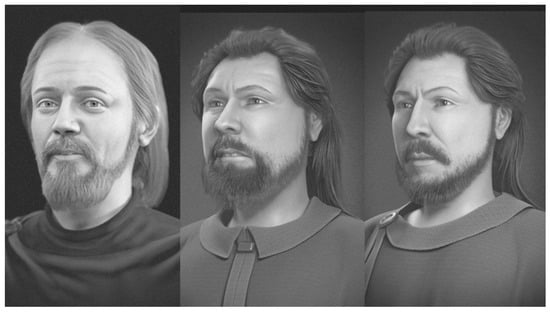
Figure 10.
From left to right: Wenceslas, Vratislav I (Wenceslas’s father), and Spytihněv I (Wenceslas’s uncle).
3.3. Limitations of the Technique
In recent years, team members of this project have presented various religious figures, such as St. Anthony of Padua [24], Ludmila of Bohemia [11], and Adalbert of Prague [12], as well as historical figures, including Jan Žižka [9], Tutankhamun [16], Amenhotep III [25], Mozart [26], and Giovanni Battista Morgagni, recognized as the father of pathological anatomy [27]. All cited cases were published in peer-reviewed journals, demonstrating adherence to expected academic standards. However, with historical figures, questions often arise about skull authenticity, as it is frequently impossible to confirm whether they truly belonged to the attributed individuals.
Among the cited facial approximations, the skull with the strongest evidence, including DNA confirming authenticity, is Morgagni’s. In other cases, attribution relies on tradition, associated documentation—as with St. Anthony—or cross-referenced historical data and accounts, as with Mozart. The latter underwent DNA testing, but samples from alleged relatives showed no match with each other or the composer. Specifically for Wenceslas, identification is tied to tradition and preserved documents indicating it as the saint’s skull. Thus, this study does not categorically affirm its authenticity, limiting itself to the interpretation of experts who analyzed the remains, with the caveat that it concerns the alleged skull. Considering the evident limitations, it is the role of researchers to adopt a precise approach using objective parameters grounded in academic literature. Even if the skull under analysis does not belong to the initially attributed individual, but to another, the employed methodology was based on replicable criteria consistent with the morphological characteristics of the skull. This approach ensures the scientific validity of the work, even if expectations regarding identification are later frustrated.
Regarding the technique’s precision, the term forensic facial approximation is always worth emphasizing, meaning efforts focused on achieving a face compatible with the individual in life using studies of living anatomies as reference, though this does not guarantee 100% compatibility. However, team members have worked on real police cases, one published where, using more traditional techniques—before the enhancements in this study—a crime victim’s face was approximated, leading to recognition and subsequent identification [15].
Given the wide age range presented in the study by Vlček (1997) [2], which spans from 30 to 60 years, we chose to maintain a facial structure consistent with the most likely age within that range, indicative of 30 to 40 years. Such broad margins are relatively common in the field of forensic facial approximation and are addressed through the objective version, in grayscale with closed eyes, which in this case depicted an adult male individual, maintaining the statistical and anatomical coherence of the approximated face, as corroborated by real cases previously handled by the authors [15].
A concern with the approach here relates to potential inaccuracy in reconstructing a skull from photographs. This is significantly mitigated by the fact that OrtogOnBlender’s primary use is for planning real surgeries. The developers’ and users’ accumulated knowledge stems from analyzing and manipulating real anatomy scans, particularly of the head, applied in procedures like orthognathic surgeries [28], mandibular fracture correction in adults [29], rhinoplasty [30], facial prosthesis creation for oncology patients [31]), and mandibular correction in infants [32]. As a critical approach requiring often submillimetric precision, the tools for structural reconstruction and estimation of missing regions are developed from real cases using living individuals’ anatomies.
Although at first glance, it may seem that medical and archaeological studies (in the context of facial approximation) lack compatibility, both share human anatomy as their foundation. In the case of studies related to surgical planning, the approach extends beyond the mere reconstruction of computed tomography to predict future changes, encompassing the use of other sources for structural reconstruction, such as two-dimensional radiographs, reconstruction of missing structures, and the analysis and measurement of characteristics from distinct ancestral populations. This methodology enables the understanding and projection of data that can be coherently applied to the field of forensic facial approximation, as demonstrated by the references to a previous study that served as the basis for the present work [9]. The structural coherence of skull reconstruction from photographs is strengthened by two other studies that also used this approach and generated structures consistent with previous work, whether the skull or the face of the approximated individual [16,25,26].
A subsequent step in the forensic facial approximation process involved the digitization of the relic of Saint Wenceslas through photogrammetry [33] using photographs from the collection of Prague Castle. The aim was to compare the resulting model with the skull employed in this study. The photo series was processed using Reality Capture software (https://www.capturingreality.com/, accessed on 5 June 2025), generating a three-dimensional mesh compatible with the skull covered by fabric (Figure 11A). Although the images were not originally captured following standard photogrammetric protocols—which resulted in limited lateral coverage of the object—the generated model provided satisfactory coverage of the frontal portion. When imported into Blender and compared to the model used in this study, it proved to be consistent with the structure and external boundaries of the skull, conforming well to the morphology of the relic and structurally complementing the regions not covered by the photogrammetry (Figure 11B–D). Although direct digitization remains the gold standard and is strongly recommended whenever feasible, this complementary comparison step reinforces the robustness of the cranial reconstruction technique based on a virtual donor adjusted to photographs, demonstrating sufficient structural adequacy for the purposes of forensic facial approximation.
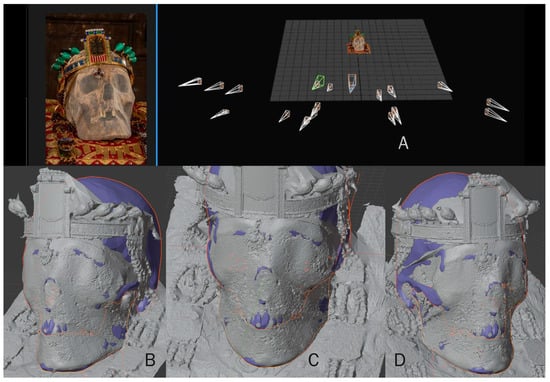
Figure 11.
Comparison between the model digitized by photogrammetry and the skull adjusted from photographs. (A) Model digitized in 3D by photogrammetry. (B–D) Comparison between the model digitized by photogrammetry in gray and the skull used in the present study, in purple and orange lines.
4. Conclusions
This work offers a new perspective on Wenceslas, Duke of Bohemia and patron saint of the Czech Republic, through digital forensic facial reconstruction. By combining analytical techniques with historical data, it estimated the physical appearance of a key Přemyslid dynasty figure whose influence endures across centuries, bridging past and present. Analysis of the skull attributed to the saint, preserved in St. Vitus Cathedral, yielded facial representations that despite limitations regarding material authenticity and the method’s approximate nature, show consistency with anthropological descriptions and historical artistic depictions, such as Petr Parler’s statue. These images not only humanize Wenceslas, making him more accessible to today’s public, but also reinforce his significance as a symbol of Czech identity. Furthermore, the study underscores the value of digital technologies in preserving and disseminating cultural heritage, forging a link between anthropology, history, and society. Thus, it provides a renewed view of this iconic figure, enriching the understanding of his legacy.
Author Contributions
Conceptualization, C.M.; methodology, C.M. and J.Y.A.; software, C.M.; validation, J.Š., M.Š. and P.K.; resources, J.Y.A.; data curation, C.M. and J.F.; writing—original draft preparation, C.M.; writing—review and editing, F.M.G., J.Y.A., P.K. and T.B.; visualization, J.Š. and J.F.; project administration, M.Š., F.M.G. and T.B.; funding acquisition, J.Y.A. All authors have read and agreed to the published version of the manuscript.
Funding
This research received no external funding.
Data Availability Statement
Data are available upon request.
Conflicts of Interest
The authors declare no conflicts of interest. Author Cicero Moraes was employed by the company Ortogonline Treinamento em Desenvolvimento Profissional e Consultoria Ltd.a. Jiří Šindelář is attached with GEO-CZ, a limited liability company based in Mladá Vožice, Czech Republic and specialize in services related to geophysical surveying and mapping. The remaining authors declare that the research was conducted in the absence of any commercial or financial relationships that could be construed as a potential conflict of interest.
References
- Dušan, T. Počátky Přemyslovců. Vstup Čechů do Dějin; Lidové Noviny: Praha, Czech Republic, 2008; pp. 530–935. ISBN 978-80-7106-138-0. [Google Scholar]
- Vlček, E. Kniže svatý Václav—Vévoda české země. In Nejstarší Přemyslovci: Atlas Kosterních Pozůstatků Prvních Sedmi Historicky Známých Generací Přemyslovců S Podrobným Komentářem a Historickými Poznámkami, 1st ed.; fyzické osobnosti českých panovníků [Prince Saint Wenceslas—Duke of the Czech Land. In: The Oldest Přemyslids: An atlas of skeletal remains of the first seven historically known generations of the Přemyslids with detailed commentary and historical notes; physical personalities of the Czech monarchs]; Vesmír: Praha, Czech Republic, 1997. [Google Scholar]
- Lutovský, M. Bratrovrah a Tvůrce Státu. Život a Doba Knížete Boleslava I; Vesmir: Praha, Czech Republic, 1998. [Google Scholar]
- Podlaha, A. Hrob svatého Václava. In Svatováclavský Sborník: Na Památku 1000. Výrocǐ Smrti Knízěte Václava Svatého; I, Kníže Václav Svatý a jeho doba [The Tomb of Saint Wenceslas. In: Saint Wenceslas Proceedings: In Commemoration of the 1000th Anniversary of the Death of Prince Wenceslas the Saint. I, Prince Wenceslas the Saint and His Time]; Národní Výbor Pro Oslavu Svatováclavského Tisícíletí: Praha, Czech Republic, 1934. [Google Scholar]
- Petráň, Z. První České Mince; Set Out Publisher: Praha, Czech Republic, 1998. [Google Scholar]
- Justa, P.; Bayerová, T.; Bayer, K. A new look at the St Wenceslas sculpture in St Vitus Cathedral, Prague, Czech Republic. Stud. Conserv. 2012, 57 (Suppl. 1), S165–S172. [Google Scholar] [CrossRef]
- Matiegka, J. Anthropologické vyšetření ostatků sv. Václava. In Svatováclavský Sborník: Na Památku 1000. Výrocǐ Smrti Knížete Václava Svatého; I, Kníže Václav Svatý a jeho doba [Anthropological examination of the remains of St. Wenceslas. In: St. Wenceslas Proceedings: In memory of the 1000th anniversary of the death of Prince Wenceslas the Saint. I, Prince Wenceslas the Saint and his time]; Národní Výbor Pro Oslavu Svatováclavského Tisícíletí: Praha, Czech Republic, 1934; Available online: https://cs.wikisource.org/wiki/Svatov%C3%A1clavsk%C3%BD_sborn%C3%ADk_na_pam%C3%A1tku_1000._v%C3%BDro%C4%8D%C3%AD_smrti_kn%C3%AD%C5%BEete_V%C3%A1clava_svat%C3%A9ho,_I._d%C3%ADl/Anthropologick%C3%A9_vy%C5%A1et%C5%99en%C3%AD_ostatk%C5%AF_sv._V%C3%A1clava (accessed on 5 June 2025).
- Saraceni, J.E. Face of 45,000-year-old modern human woman reconstructed. Archaeological Magazine. 2023. Available online: https://archaeology.org/news/2023/07/31/230801-czech-modern-human/ (accessed on 5 June 2025).
- Moraes, C.; Abdullah, J.Y.; Šindelář, J.; Šindelář, M.; Thomová, Z.; Smrčka, J.; Vaccarezza, M.; Beaini, T.; Galassi, F.M. The Facial Approximation of the Skull Attributed to Jan Žižka (ca. AD 1360–1424). Heritage 2024, 8, 7. [Google Scholar] [CrossRef]
- Davis-Marks, I. 3-D Reconstructions Reveal the Faces of Two Medieval Dukes. Smithsonian Magazine. 2021. Available online: https://www.smithsonianmag.com/smart-news/researchers-reconstruct-faces-two-premyslid-dynasty-dukes-180977228/ (accessed on 5 June 2025).
- Kar. Vědci Rekonstruovali Podobu KNĚŽNY Ludmily. Podívejte Se Do Tváře Patronky Čech. ČT24—Česká Televize. 2021. Available online: https://ct24.ceskatelevize.cz/clanek/veda/vedci-rekonstruovali-podobu-knezny-ludmily-podivejte-se-do-tvare-patronky-cech-29441 (accessed on 5 June 2025).
- Erpen, J. Apresentado em Praga rosto de Santo Adalberto, Obra de Designer 3D Brasileiro. Vatican News. 2021. Available online: https://www.vaticannews.va/pt/igreja/news/2024-05/sao-adalberto-praga-reconstituicao-facial-cicero-moraes.html (accessed on 5 June 2025).
- Frinta, O.; Frintová, D. Cathedral of Sts. Vitus, Wenceslas, and Adalbert—The Melting Pot of Czech Religious, National, and State Identity and Its Legal Status. Laws 2023, 12, 25. [Google Scholar] [CrossRef]
- Ministry of Foreign Affairs of the Czech Republic. St. Wenceslas Czech National Day. 2021. Available online: https://mzv.gov.cz/file/4409722/St._Wenceslas_Czech_National_Day_2021.pdf (accessed on 5 June 2025).
- Baldasso, R.P.; Moraes, C.; Gallardo, E.; Stumvoll, M.B.; Crespo, K.C.; Strapasson, R.A.P.; de Oliveira, R.N. 3D forensic facial approximation: Implementation protocol in a forensic activity. J. Forensic Sci. 2020, 66, 383–388. [Google Scholar] [CrossRef] [PubMed]
- Moraes, C.; Habicht, M.E.; Galassi, F.M.; Varotto, E.; Beaini, T. Pharaoh Tutankhamun: A novel 3D digital facial approximation [Internet]. In Italian Journal of Anatomy and Embryology; Firenze University Press: Firenze, Italy, 2023; Volume 127, pp. 13–22. [Google Scholar] [CrossRef]
- De Greef, S.; Claes, P.; Vandermeulen, D.; Mollemans, W.; Suetens, P.; Willems, G. Large-scale in-vivo Caucasian facial soft tissue thickness database for craniofacial reconstruction. Forensic Sci. Int. 2006, 159, S126–S146. [Google Scholar] [CrossRef] [PubMed]
- Zhou, S.; Chan, K.C.K.; Li, C.; Loy, C.C. Towards Robust Blind Face Restoration with Codebook Lookup Transformer (Version 2). arXiv 2022, arXiv:2206.11253. [Google Scholar]
- Lebedinskaya, G.V. Rekonstruktsia Litsa po Cherepu—Metodicheskoye Rukovodstvo; Facial Reconstruction from the Skull—Methodological Guide; Staryj Sad: Moscow, Russia, 1998. [Google Scholar]
- Stephan, C.N.; Henneberg, M.; Sampson, W. Predicting nose projection and pronasale position in facial approximation: A test of published methods and proposal of new guidelines. Am. J. Phys. Anthropol. 2003, 122, 240–250. [Google Scholar] [CrossRef] [PubMed]
- Ballestriero, R. Anatomical models and wax Venuses: Art masterpieces or scientific craft works? J. Anat. 2010, 216, 223–234. [Google Scholar] [CrossRef] [PubMed]
- Welcker, H. Schiller’s Schadel und Todtenmaske: Nebst Mittheilungen uber Schadel und Todtenmaske Kant’s/von Hermann Welcker. Braunschweig; Schiller’s skull and death mask: With information on Kant’s skull and death mask/by Hermann Welcker; F. Vieweg: Braunschweig, Germany, 1883. [Google Scholar]
- His, W. Anatomische Forschungen über Johann Sebastian Bach’s Gebeine und Antlitz Nebst Bemerkungen Über Dessen Bilder; Anatomical research on Johann Sebastian Bach’s bones and face, together with remarks on his pictures; S. Hirzel: Leipzig, Germany, 1895. [Google Scholar]
- Radley, D. Saint Anthony of Padua revealed in 3D facial approximation. Archaeological Magazine. 2022. Available online: https://archaeologymag.com/2022/12/saint-anthony-of-padua-revealed-in-3d-facial-approximation/ (accessed on 5 June 2025).
- Moraes, C.; Habicht, M.E.; Artico, M.; Forte, F.; Varotto, E.; Galassi, F.M. The mummy of Pharaoh Amenhotep III (reigned ca. 1388–1351 and its facial approximation: An anatomical approach. Clin. Anat. 2024, 38, 211–215. [Google Scholar] [CrossRef] [PubMed]
- Moraes, C.; Šindelář, J.; Habicht, M.E.; Sineo, L.; Beaini, T.; Varotto, E.; Galassi, F.M. The Facial approximation of the controversial skull attributed to Wolfgang Amadeus Mozart (1756–1791). Anthropol. Rev. 2025, 87, 89–101. [Google Scholar] [CrossRef]
- Redazione. Ecco Il Vero Volto di Morgagni: Ricostruito dal Cranio L’aspetto del Celebre Medico Forlivese. Forli Today. 2015. Available online: https://www.forlitoday.it/cronaca/volto-morgagni-cranio-medico-forlivese.html (accessed on 5 June 2025).
- Lobo, F.; Filho, L.I.; Sigua-Rodriguez, E.A.; da Silva, B.G.; Tolentino Ede, S.; Borges, Y.M.; da Silva, M.C.; Tonin, R.H.; Iwaki, L.C.V. Evaluation of ortogonblender software bone movement tools in bimaxillary orthognatic surgeries performed in dolphin software. J. Stomatol. Oral Maxillofac. Surg. 2022, 123, 417–421. [Google Scholar] [CrossRef] [PubMed]
- Façanha de Carvalho, E.; Alkmin Paiva, G.L.; Yonezaki, F.; Machado, G.G. Computer-Aided Surgical Simulation in Severe Atrophic Mandibular Fractures: A New Method for Guided Reduction and Temporary Stabilization Before Fixation. J. Oral Maxillofac. Surg. 2021, 79, 892.e1–892.e7. [Google Scholar] [CrossRef] [PubMed]
- Sobral, D.S.; Duarte, D.W.; Dornelles, R.F.V.; Moraes, C.A.C. 3D Virtual Planning for Rhinoplasty Using a Free Add-On for Open-Source Software. Aesthetic Surg. J. 2021, 41, NP1024–NP1032. [Google Scholar] [CrossRef] [PubMed]
- Salazar-Gamarra, R.; Cárdenas-Bocanegra, A.; Masch, U.; Da Costa Moraes, C.A.; Seelaus, R.; Lopes Da Silva, J.V.; Lauria Dib, L. Color translation from monoscopic photogrammetry +ID Methodology into a Polyjet final 3D printed facial prosthesis. F1000 Res. 2022, 11, 582. [Google Scholar] [CrossRef] [PubMed]
- Duarte, D.W.; Fleith, I.J.; Pinheiro, R.C.; Machado, M.F.; Zanin, E.M.; Collares, M.V.M. Mandibular morphology and distraction osteogenesis vectors in patients with Robin sequence. Int. J. Oral Maxillofac. Surg. 2023, 52, 442–450. [Google Scholar] [CrossRef] [PubMed]
- Šindelář, J.; Poláček, L.; Krupičková, Š. Doporučená metodika fotodokumentace v archeologii pro následné metrické analýzy obrazu. Přehled Výzkumů 2019, 60, 201–224. Available online: http://prehled-vyzkumu.arub.avcr.cz/miranda2/export/sitesavcr/arub-prehled-vyzkumu/prehled-cisel-a-clanku/prehled-vydanych-cisel/files/pv_60_2_sindelar_et_al.pdf (accessed on 5 June 2025).
Disclaimer/Publisher’s Note: The statements, opinions and data contained in all publications are solely those of the individual author(s) and contributor(s) and not of MDPI and/or the editor(s). MDPI and/or the editor(s) disclaim responsibility for any injury to people or property resulting from any ideas, methods, instructions or products referred to in the content. |
© 2025 by the authors. Licensee MDPI, Basel, Switzerland. This article is an open access article distributed under the terms and conditions of the Creative Commons Attribution (CC BY) license (https://creativecommons.org/licenses/by/4.0/).